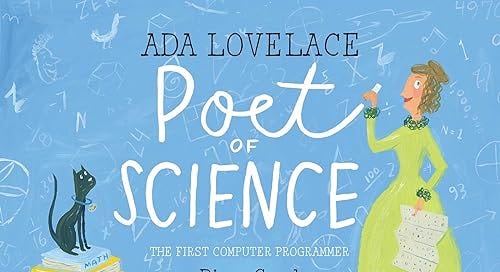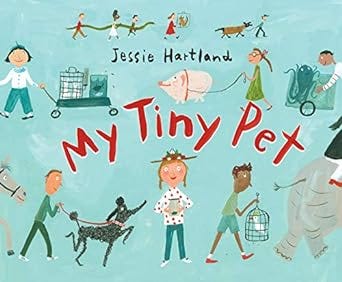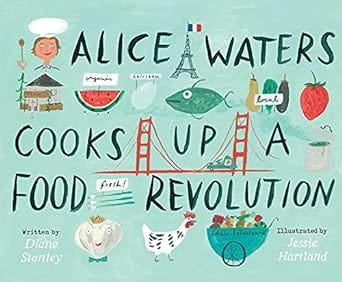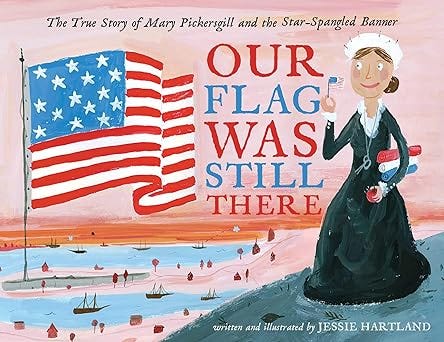Ada Lovelace + Alice Waters - Book for Kids
Ada Lovelace, Alice Waters, and a few other fun books for kids by a favorite illustrator
Ada Lovelace Day is this week, and I’ve had this book review sitting for a while. It’s okay if you missed the actual “Ada Lovelace Day.” Books like this are great exposure and inspiration for kids at any time of the year!
A book that always stands out for me from the many, many books I have talked about on the podcast was Jessie Hartland’s book about Julia Child, Bon Appetit!: The Delicious Life of Julia Child. I absolutely loved it. I also really enjoyed her book on Steve Jobs.
Because the Julia Child book had come to mind as an old favorite, I checked out a stack of other books illustrated by Hartland recently. One of those books was about Ada Lovelace.
Ada Lovelace: Poet of Science: The First Computer Programmer, by Diane Stanley and illustrated by Jessie Hartland
I love this one! Ada Lovelace is a well-known name today for those interested in recovering the stories of women in STEM. (Ada was also poet Lord Byron’s daughter.) This children’s book brings Ada to life as someone with a strong imagination and an equally strong analytical side. (It’s a combo I love.)
As a young girl, the book shows us how Ada imagined creating wings to enable her to fly. It’s probably a common whimsical thought, but we are shown in detail what Ada envisioned and how she thought she would put the wings to use and even the book she thought she would write, Flyology.
“Ada was good at imagining things. She imagined it would be fun to fly. Then she went about it in a scientific way. First, she studied the flight and the anatomy of birds.”
Her mother, thinking Ada too imaginative, made sure she was well educated in math and science. The book mixes in a number of details to provide historical context of the Industrial Revolution and describes Ada seeing a mechanical loom (designed by Joseph Marie Jacquard). Ada was fascinated by how the loom was given instructions on cards to create the woven design.
Ada’s story has it all, from ballrooms (where she felt out of place) to the home of Charles Babbage, where she met writers and thinkers of the time, like Charles Dickens and Charles Darwin.
“They talked about important things: astronomy and politics, literature and art, and the latest engineering marvels. These were her kind of people.”
It is with Babbage that she worked on a manuscript that contained both an explanation of how his proposed Analytical Machine would work as well as an example of how to program the machine with Bernoulli’s numbers—a computer program.
This is a great children’s book biography, and Hartland’s art is charming and wonderful. The style is perfectly suited to Ada’s story and brings the details wonderfully to life on the page with whimsy, color, and a combination of fun and excitement.
My Tiny Pet by Jessie Hartland
My Tiny Pet has roots in the “tiny house” movement. The main character starts out living in a large house with a menagerie of animals. But then her family decides to “simplify,” and the animals are all rehomed. The first few pages are a riot of animals filling the house, sure to delight readers.
The family moves to a small house in the woods, and her parents say “no” to a pet. When she learns about “micro animals” in school, she thinks she has a solution. After convincing her parents to consider a tiny pet, one that will require a microscope, they go foraging and find a tardigrade (a water bear). When they downsize again, she’s all set. This is a charming story, and the illustrations are wonderful.
Alice Waters Cooks Up a Food Revolution by Diane Stanley and illustrated by Jessie Hartland
This is a great biography of Alice Waters and what led her to open Chez Panisse (in California). The story chronicles the importance of eating foods fresh from the garden in her childhood and the influence of time spent in France where she has “the best soup” and “the best breakfast” and many other “best” foods. This becomes a guiding principle when she and her friends open Chez Panisse. Her quest for the “best” tasting experience leads her to source foods from small local farmers. Passing reference is made in the final pages to school children getting to experience fresh foods, but the end notes contain a more in-depth story about The Edible Schoolyard project she brought to fruition at a school in Berkeley. (Versions of this now exist in schools around the country.)
I also looked at Our Flag Was Still There: The True Story of Mary Pickersgill and the Star-Spangled Banner by Jessie Hartland. It was an interesting version of a story you may not know!
(Links to books are Amazon affiliate links that help support the Creativity Matters Podcast and the Illustrated Life substack. Always check your library!)








